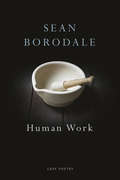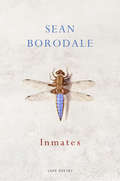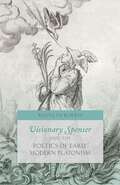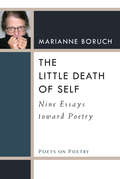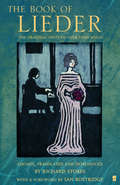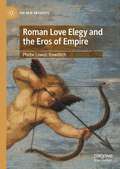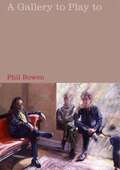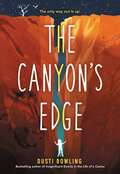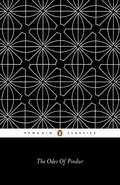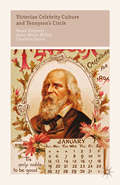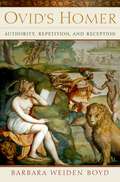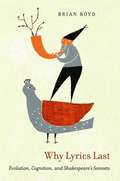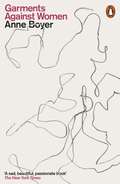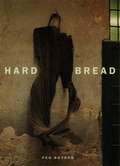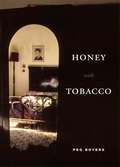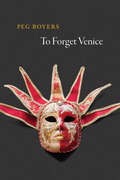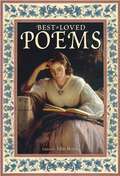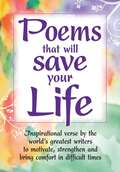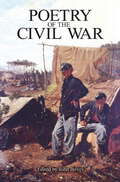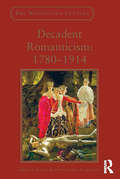- Table View
- List View
Human Work: A Poet's Cookbook
by Sean BorodaleHuman Work was written while cooking. It is the narrative of a voice in domesticity, at the alchemical heart of home – the hearth, or Hestia – where the kitchen is a stage for acts of eating and uttering; for the ebb and flow to the human mouth. The poems were written ‘live’ among pots and pans, beside chopping boards, between plates, bowls, knives, forks, spoons, and servings. Their time is the hybrid time of writing and cooking – where the dimensions of two activities hinge together. The poems occupy a shared space; the work is one work. They live together and cross-talk, like figures in a room, invoking an old story, perhaps one of our very first: how we make food to eat and share, how we draw and transform others’ bodies into being our own flesh and life. Implicit in ingredients are the stories of matter itself: without food there can be no other stories.Like the poems of Bee Journal these poems started life in notebooks, in situ. Their pages seem marked with the very process of their making: jam, grease, wine stains, crumbs of flour and spice, flecks of meat, fish, fruit, vegetable. Like Bee Journal, this is a book about communal purpose, a record of risk and response – a poetry of the moment, both immemorial and thrillingly modern.
Inmates
by Sean BorodaleThe poems of Inmates stage encounters with insects at sites and moments of their refuge, torpor, hatching or fighting, of traversing a floor in the night or climbing a wall, of their death and decay – all in and around the house of the writer, with whom they are sharing time, as fellow inmates. There is an urgency to these poems, emerging from the instant of their writing, and the close attention Borodale brings to his observation of the natural world results in poems of real intensity. Inmates is an attempt to co-exist with the natural world – examining it, intimately, at the edge of language itself, where the human voice begins to break apart.
Visionary Spenser and the Poetics of Early Modern Platonism
by Kenneth BorrisPlatonic concerns and conceptions profoundly affected early modern English and continental poetics, yet the effects have had little attention. This book defines Platonism's roles in early modern theories of literature, then reappraise the Platonizing major poet Edmund Spenser. It makes important new contributions to the knowledge of early modern European poetics and advances our understanding of Spenser's role and significance in English literary history. Literary Platonism energized pursuits of the sublime, and knowledge of this approach to poetry yields cogent new understandings of Spenser's poetics, his principal texts, his poetic vocation, and his cultural influence. By combining Christian resources with doctrines of Platonic poetics such as the poet's and lover's inspirational furies, the revelatory significance of beauty, and the importance of imitating exalted ideals rather than the world, he sought to attain a visionary sublimity that would ensure his enduring national significance, and he thereby became a seminal figure in the English literary "line of vision" including Milton and Blake among others. Although readings of Spenser's Shepheardes Calender typically bypass Plato's Phaedrus, this text deeply informs the Calender's treatments of beauty, inspiration, poetry's psychagogic power, and its national responsibilities. In The Faerie Queene, both heroism and visionary poetics arise from the stimuli of love and beauty conceived Platonically, and idealized mimesis produces its faeryland. Faery's queen, projected from Elizabeth I as in Platonic idealization of the beloved, not only pertains to temporal governance but also points toward the transcendental Ideas and divinity. Whereas Plato's Republic valorizes philosophy for bringing enlightenment to counter society's illusions, Spenser champions the learned and enraptured poetic imagination, and proceeds as such a philosopher-poet.
Visionary Spenser and the Poetics of Early Modern Platonism
by Kenneth BorrisPlatonic concerns and conceptions profoundly affected early modern English and continental poetics, yet the effects have had little attention. This book defines Platonism's roles in early modern theories of literature, then reappraise the Platonizing major poet Edmund Spenser. It makes important new contributions to the knowledge of early modern European poetics and advances our understanding of Spenser's role and significance in English literary history. Literary Platonism energized pursuits of the sublime, and knowledge of this approach to poetry yields cogent new understandings of Spenser's poetics, his principal texts, his poetic vocation, and his cultural influence. By combining Christian resources with doctrines of Platonic poetics such as the poet's and lover's inspirational furies, the revelatory significance of beauty, and the importance of imitating exalted ideals rather than the world, he sought to attain a visionary sublimity that would ensure his enduring national significance, and he thereby became a seminal figure in the English literary "line of vision" including Milton and Blake among others. Although readings of Spenser's Shepheardes Calender typically bypass Plato's Phaedrus, this text deeply informs the Calender's treatments of beauty, inspiration, poetry's psychagogic power, and its national responsibilities. In The Faerie Queene, both heroism and visionary poetics arise from the stimuli of love and beauty conceived Platonically, and idealized mimesis produces its faeryland. Faery's queen, projected from Elizabeth I as in Platonic idealization of the beloved, not only pertains to temporal governance but also points toward the transcendental Ideas and divinity. Whereas Plato's Republic valorizes philosophy for bringing enlightenment to counter society's illusions, Spenser champions the learned and enraptured poetic imagination, and proceeds as such a philosopher-poet.
The Little Death of Self: Nine Essays toward Poetry (Poets On Poetry)
by Marianne BoruchA volume in the Poets on Poetry series, which collects critical works by contemporary poets, gathering together the articles, interviews, and book reviews by which they have articulated the poetics of a new generation. The line between poetry (the delicate, surprising not-quite) and the essay (the emphatic so-there!) is thin, easily crossed. Both welcome a deep mulling-over, endlessly mixing image and idea and running with scissors; certainly each distrusts the notion of premise or formulaic progression. Marianne Boruch’s essays in The Little Death of Self emerged by way of odd details or bothersome questions that would not quit—Why does the self grow smaller as the poem grows enormous? Why does closure in a poem so often mean keep going? Must we stalk the poem or does the poem stalk us until the world clicks open? Boruch’s intrepid curiosity led her to explore fields of expertise about which she knew little: aviation, music, anatomy, history, medicine, photography, fiction, neuroscience, physics, anthropology, painting, and drawing. There’s an addiction to metaphor here, an affection for image, sudden turns of thinking, and the great subjects of poetry: love, death, time, knowledge. There’s amazement at the dumb luck of staying long enough in an inkling to make it a poem at all. Poets such as Keats, Stevens, Frost, Plath, Auden, and Bishop, along with painters, inventors, doctors, scientists, composers, musicians, neighbors, friends, and family—all traffic blatantly or under the surface—and one gets a glimpse of such fellow travelers now and then.
The Book of Lieder
by Dr Ian Bostridge Richard StokesThis unique volume contains, in parallel translation, a thousand of the most frequently performed Lieder, both piano-accompanied and orchestral. Composers are arranged alphabetically, with their songs appearing under poet in chronological order of composition - thus allowing the reader to engage in depth with a particular poet and at the same time to follow the composer's development. Richard Stokes, whose work in this field is already widely acclaimed, provides illuminating short essays on each of the fifty composers' approach to Lieder composition, as well as well as notes on all the poets who inspired the songs.The volume is notable for the accuracy and elegance of its translations, and for its fidelity to the German verse: every care has been taken to print the words of the sung text, while adhering to the versification and punctuation of the original poem.Beethoven, Schubert and Schumann, Goethe, Heine and Schiller are among the highlights of a book which illuminates one of the great musical traditions and will be an indispensable handbook for every music lover.
Roman Love Elegy and the Eros of Empire (The New Antiquity)
by Phebe Lowell BowditchThis book explores Roman love elegy from postcolonial perspectives, arguing that the tropes, conventions, and discourses of the Augustan genre serve to reinforce the imperial identity of its elite, metropolitan audience. Love elegy presents the phenomena and discourses of Roman imperialism—in terms of visual spectacle (the military triumph), literary genre (epic in relation to elegy), material culture (art and luxury goods), and geographic space—as intersecting with ancient norms of gender and sexuality in a way that reinforces Rome’s dominance in the Mediterranean. The introductory chapter lays out the postcolonial frame, drawing from the work of Edward Said among other theorists, and situates love elegy in relation to Roman Hellenism and the varied Roman responses to Greece and its cultural influences. Four of the six subsequent chapters focus on the rhetorical ambivalence that characterizes love elegy’s treatment of Greek influence: the representation of the domina or mistress as simultaneously a figure for ‘captive Greece’ and a trope for Roman imperialism; the motif of the elegiac triumph, with varying figures playing the triumphator, as suggestive of Greco-Roman cultural rivalry; Rome’s competing visions of an Attic and an Asiatic Hellenism. The second and the final chapter focus on the figures of Osiris and Isis, respectively, as emblematic of Rome’s colonialist and ambivalent representation of Egypt, with the conclusion offering a deconstructive reading of elegy’s rhetoric of orientalism.
A Gallery to Play to: The Story of the Mersey Poets
by Phil BowenA Gallery to Play to is an intimate account of the lives and careers of the poets Adrian Henri, Roger McGough and Brian Patten. With unparalleled access to the three writers, Phil Bowen has written an indispensable book for anyone interested in poetry, popular culture and society over the last forty years.
The Canyon's Edge
by Dusti BowlingHatchet meets Long Way Down in this heartfelt and gripping novel in verse about a young girl's struggle for survival after a climbing trip with her father goes terribly wrong. One year after a random shooting changed their family forever, Nora and her father are exploring a slot canyon deep in the Arizona desert, hoping it will help them find peace. Nora longs for things to go back to normal, like they were when her mother was still alive, while her father keeps them isolated in fear of other people. But when they reach the bottom of the canyon, the unthinkable happens: A flash flood rips across their path, sweeping away Nora's father and all of their supplies. Suddenly, Nora finds herself lost and alone in the desert, facing dehydration, venomous scorpions, deadly snakes, and, worst of all, the Beast who has terrorized her dreams for the past year. If Nora is going to save herself and her father, she must conquer her fears, defeat the Beast, and find the courage to live her new life.
The Odes of Pindar
by Cecil Bowra'What Pindar catches is the joy beyond ordinary emotions as it transcends and transforms them' - C. M. BowraArguably the greatest Greek lyric poet, Pindar (518-438 B. C.) was a controversial figure in fifth-century Greece - a conservative Boiotian aristocrat who studied in Athens and a writer on physical prowess whose interest in the Games was largely philosophical. Pindar's Epinician Odes - choral songs extolling victories in the Games at Olympia, Delphi, Nemea and Korinth - cover the whole spectrum of the Greek moral order, from earthly competition to fate and mythology. But in C. M. Bowra's clear translation his one central image stands out - the successful athlete transformed and transfigured by the power of the gods.Translated with an introduction by C. M. Bowra.
Victorian Celebrity Culture and Tennyson's Circle
by C. Boyce P. Finnerty A. MillimTennyson experienced at first hand the all-pervasive nature of celebrity culture. It caused him to retreat from the eyes of the world. This book delineates Tennyson's reluctant celebrity and its effects on his writings, on his coterie of famous and notable friends and on the ever-expanding, media-led circle of Tennyson's admirers.
Ovid's Homer: Authority, Repetition, Reception
by Barbara Weiden BoydOvid's Homer examines the Latin poet's engagement with the Homeric poems throughout his career. Boyd offers detailed analysis of Ovid's reading and reinterpretation of a range of Homeric episodes and characters from both epics, and demonstrates the pervasive presence of Homer in Ovid's work. The resulting intertextuality, articulated as a poetics of paternity or a poetics of desire, is particularly marked in scenes that have a history of scholiastic interest or critical intervention; Ovid repeatedly asserts his mastery as Homeric reader and critic through his creative response to alternative readings, and in the process renews Homeric narrative for a sophisticated Roman readership. Boyd offers new insight into the dynamics of a literary tradition, illuminating a previously underappreciated aspect of Ovidian intertextuality.
Ovid's Homer: Authority, Repetition, Reception
by Barbara Weiden BoydOvid's Homer examines the Latin poet's engagement with the Homeric poems throughout his career. Boyd offers detailed analysis of Ovid's reading and reinterpretation of a range of Homeric episodes and characters from both epics, and demonstrates the pervasive presence of Homer in Ovid's work. The resulting intertextuality, articulated as a poetics of paternity or a poetics of desire, is particularly marked in scenes that have a history of scholiastic interest or critical intervention; Ovid repeatedly asserts his mastery as Homeric reader and critic through his creative response to alternative readings, and in the process renews Homeric narrative for a sophisticated Roman readership. Boyd offers new insight into the dynamics of a literary tradition, illuminating a previously underappreciated aspect of Ovidian intertextuality.
Why Lyrics Last: Evolution, Cognition, And Shakespeare's Sonnets
by Brian BoydWhy Lyrics Last turns an evolutionary lens on lyric verse, placing the writing of verse within the human disposition to play with pattern. Boyd takes as an extended example the many patterns to be found within Shakespeare’s Sonnets. There, the Bard avoids all narrative and demonstrates the power that verse can have when liberated of story.
Why Lyrics Last: Evolution, Cognition, And Shakespeare's Sonnets
by Brian BoydWhy Lyrics Last turns an evolutionary lens on lyric verse, placing the writing of verse within the human disposition to play with pattern. Boyd takes as an extended example the many patterns to be found within Shakespeare’s Sonnets. There, the Bard avoids all narrative and demonstrates the power that verse can have when liberated of story.
Garments Against Women
by Anne BoyerThe multi-award-winning meditation on survival, care and the place of literature in an unequal world'Around that time my daughter and I had this exchange:Anne, imagine if the world had nothing in it.Do you mean nothing at all - just darkness - or a world without objects?I mean a world without things: no houses, chairs, or cars. A world with only people and trees and dirt.What do you think would happen?People would make things. We would make things with trees and dirt.'When the cold comes, when our needs announce themselves, it is with clothing, with possessions, in literature, through dreams - in all the forms and categories that shape, contain and constrain - that we keep ourselves alive. Yet, in a society in which some are rich and some are poor, who gets to dream, and who invents our forms? This is a book made of money and the lack of money; of writing and of not-writing; of illness and of care; of low-rent apartments, cake-baking mothers, Socratic daughters and bodies that refuse to become information.
Hard Bread (Phoenix Poets)
by Peg BoyersThe poems in Peg Boyers's Hard Bread are "spoken" in the imagined voice of the Italian writer, Natalia Ginzburg (1916-91). While much of the book is based on Ginzburg's life—her upbringing in Turin; her brief marriage to the resistance activist, Leone Ginzburg; her experience of Fascism and war; her work as novelist, playwright, editor, and newspaper columnist; her embattled friendships with writers like Primo Levi, Pier Paolo Pasolini, Ernest Hemingway, and Cesare Pavese—much is invented. The result is a book by turns melancholy and acerbic, mournful and satiric, contemplative and combative.
Honey with Tobacco (Phoenix Poets)
by Peg BoyersPietà This time the migraine came with a vision bathed in night sweat: I was sitting on the Eames chair, your man’s body on my lap, legs and arms white as casein draped over mine, spilling onto the cassock, new sores on your legs, dried blood on your feet and hands, from your chalk mouth the words forgive me, from mine, the impossible no Hard Bread,Peg Boyers’s debut poetry collection, with verse spoken in the imagined voice of the Italian writer Natalia Ginzburg, was widely praised for its inspired ventriloquism and its brilliant lyricism. In Honey with Tobacco, Boyers’s own intensely personal voice emerges in three strikingly distinctive variants. The first part of the book is the most explicitly autobiographical, bringing together poems that explore the poet’s Cuban American experience and a childhood marked by travel, the tropics, and varieties of disenchantment. The middle sequence of poems concerns a mother, a father, and a son, a postmodern holy family whose ordeals are evoked in a terse, terrifying narrative. In familiar tableaux drawn from the Bible that have inspired great works of art—the Annunciation, the Pieta, and Judgment Day—Boyers explores what it means in contemporary America to be “blessed among women” and whether and how art can contain grief. The final section of the book confronts age, desire, and regret in a series of personal poems that plumb baser human instincts and the speakers’ determination to dwell in darkness, when necessary, without abandoning the sacred. Praise for Hard Bread: “A great achievement of poetic voice . . . . It’s absolutely clear what these poems are ‘about,’ and they are unapologetic in their devotion to subject, clarity, precision, and accessibility.”—Steven Cramer, Poetry
To Forget Venice (Phoenix Poets)
by Peg BoyersTo Forget Venice is the improbable challenge and the title of Peg Boyers’s newest collection of poems. The site of several unforgettable years of her adolescence, the place she has returned to more frequently than any other, the city of Venice is both adored and reviled by the speakers in this varied and unconventionally polyphonic work. The voices we hear in these poems belong not only to characters like the mother of Tadzio (think Death in Venice), or the companion of Vladimir Ilych Lenin, or the Victorian prophet John Ruskin and his wife, Effie, but also to wall moss, and sand, and—most especially—an authorial speaker who in 1965, at age thirteen, landed in Venice and never quite recovered from the formative experiences that shaped her there. Ranging over several stages of a life that features adolescent heartbreak and betrayal, marriage and children, friendship and loss, the book insistently addresses the author’s desire to get to the bottom of her obsession with a place that has imprinted itself so profoundly on her consciousness.
To Forget Venice (Phoenix Poets)
by Peg BoyersTo Forget Venice is the improbable challenge and the title of Peg Boyers’s newest collection of poems. The site of several unforgettable years of her adolescence, the place she has returned to more frequently than any other, the city of Venice is both adored and reviled by the speakers in this varied and unconventionally polyphonic work. The voices we hear in these poems belong not only to characters like the mother of Tadzio (think Death in Venice), or the companion of Vladimir Ilych Lenin, or the Victorian prophet John Ruskin and his wife, Effie, but also to wall moss, and sand, and—most especially—an authorial speaker who in 1965, at age thirteen, landed in Venice and never quite recovered from the formative experiences that shaped her there. Ranging over several stages of a life that features adolescent heartbreak and betrayal, marriage and children, friendship and loss, the book insistently addresses the author’s desire to get to the bottom of her obsession with a place that has imprinted itself so profoundly on her consciousness.
Best-Loved Poems
by John Boyes... poetry is the blossom and the fragrancy of all human knowledge, human thoughts, human passions, emotions, language.' Samuel Taylor ColeridgeThis glorious celebration of classic poetry features verse from around the English-speaking world. Carefully selected and divided into themed sections, the poems encompass the wealth of human experience - love, death, youth, old age, nature, travel and humour are all included in works that range from the 1500s onwards.A comprehensive range of time-honoured poetry from the British Isles, America, Canada, Australia and New Zealand, the collection embraces the famous and not so famous, from Blake and Wordsworth to Adeler and Wyatt, and includes over 170 other poets.From Coleridge's fantastical Xanadu or the battlefields of John McCrae, to the ominous croaking of Poe's raven, this is a wonderful collection of poems containing the great and the good, the funny and the tragic, and everything in between.
Poems that Will Save Your Life
by John BoyesHope is the thing with feathersThat perches in the soul,And sings the tune without the words,And never stops at all.- Emily DickensonFrom time immemorial, poetry has provided its readers with a source of comfort and encouragement in times of need. In this superb anthology can be found the best of the English-speaking world's inspirational and reassuring verse, including such classics as Rudyard Kipling's 'If' and W.H. Davies' 'Leisure'. This collection of over 120 poems is sure to offer solace, hearten the soul and motivate the human spirit.Includes works by Emily Brontë, Robert Burns, Emily Dickinson, George Eliot, John Keats, D.H. Lawrence, Henry Wadsworth Longfellow, Edna St. Vincent Millay, John Milton, Alfred, Lord Tennyson, Walt Whitman, William Wordsworth, and many more.
Poetry of the Civil War
by John BoyesOn January 17 1861, a few weeks after South Carolina became the first state to formally secede from the Union, Quaker poet John Greenleaf Whittier's 'A Word for the Hour' was published in The Boston Evening Transcript. It was to herald the birth of a new era of American poetry - one that expressed the hopes and fears, and the hatred and hostility, of a nation torn in two.The only conflict to be fought on American soil by Americans, the Civil War pitched brother against brother, father against son and left a legacy burned deep in the American psyche, as this superb collection of poetry reveals.In Poetry of the Civil War the tragedy, heroism, pathos, and futility of the bloodshed are brought vividly to life and leave an indelible impression of what it must have been like to live through some of the nation's darkest hours.
Decadent Romanticism: 1780-1914
by Kostas Boyiopoulos Mark SandyFor Decadent authors, Romanticism was a source of powerful imaginative revisionism, perversion, transition, and partial negation. But for all these strong Decadent reactions against the period, the cultural phenomenon of Decadence shared with Romanticism a mutual distrust of the philosophy of utilitarianism and the aesthetics of neo-Classicism. Reflecting on the interstices between Romantic and Decadent literature, Decadent Romanticism reassesses the diverse and creative reactions of Decadent authors to Romanticism between 1780 and 1914, while also remaining alert to the prescience of the Romantic imagination to envisage its own distorted, darker, perverted, other self. Creative pairings include William Blake and his Decadent critics, the recurring figure of the sphinx in the work of Thomas De Quincey and Decadent writers, and Percy Shelley with both Mathilde Blind and Swinburne. Not surprisingly, John Keats’s works are a particular focus, in essays that explore Keats’s literary and visual legacies and his resonance for writers who considered him an icon of art for art’s sake. Crucial to this critical reassessment are the shared obsessions of Romanticism and Decadence with subjectivity, isolation, addiction, fragmentation, representation, romance, and voyeurism, as well as a poetics of desire and anxieties over the purpose of aestheticism.
